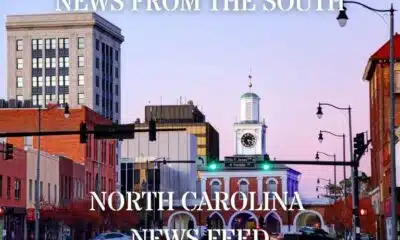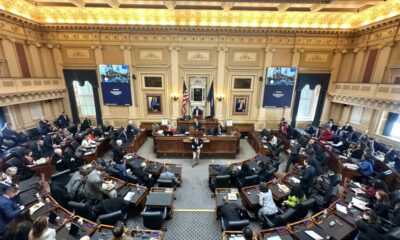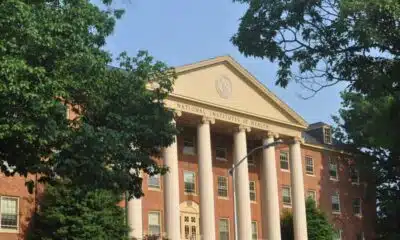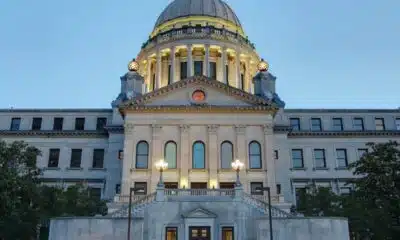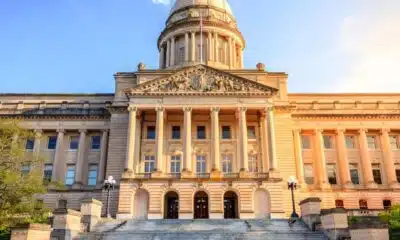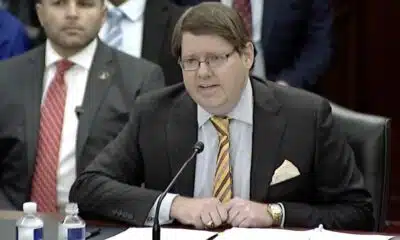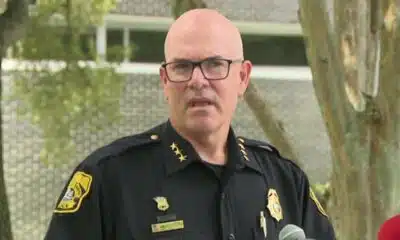News from the South - Virginia News Feed
Voting begins on Richmond’s $3 million People’s Budget
by Charlotte Rene Woods, Virginia Mercury
April 1, 2025
Last summer, the city of Richmond made waves by announcing a $3 million dollar check for its residents to spend as they see fit. Now, the city is handing the reins over to its people, inviting everyone 14 years and older to vote on how that money should be allocated. From April 1 to 15, Richmonders can head to pop-up events around the city or log on to cast their votes for the projects they want to see funded in what the city has dubbed “The People’s Budget.”
Ideas on the table range from improvements to bus routes, tree plantings in underserved areas, and sidewalk enhancements for pedestrian safety, to more region-specific projects, like a “Welcome to Southside” sign at entry points to Richmond’s 8th City Council district, or better trail access to the James River in the 5th District.
Instead of just picking one project, the process uses ranked choice voting, allowing participants to express preference for several initiatives. The People’s Budget initiative, which was led by former city councilor and mayoral candidate Andreas Addison, started with other pop-up events and online solicitation to gather input from residents across the city.
As for the $3 million, it’s being divided across the city with a focus on equity. Isaac Samuels, lead organizer of the People’s Budget, explained that Districts 1, 2 and 4 will each get $200,000, while Districts 3, 5 and 7 will receive $300,000 each, and Districts 6, 8 and 9 will be allocated $500,000. The goal of this varied distribution is to direct funding to areas that have historically been underinvested in, ensuring that all of Richmond’s neighborhoods benefit.
Richmond’s Southside, home to many historically Black neighborhoods, has long faced challenges rooted in systemic inequality. Less tree canopy in these areas leads to higher ground temperatures during hot months, and a history of discriminatory housing policies has contributed to lower home values.
In the 1930s, appraisers marked Black-populated neighborhoods nationwide in red, labeling them “hazardous” for home loans. The lasting impact of these racist practices is still evident today, with each negative appraisal continuing to affect future evaluations and resulting in less local government investment in public infrastructure.
“This is a big milestone for us,” Samuels said.
After months of outreach and community engagement, Samuels is thrilled to reach the voting phase, knowing the projects selected will soon become a reality. With voting ending on April 15, he expects the results to be available by April 21.
From there, the implementation of winning proposals will vary based on which city departments are involved and the procedural steps leading up to any development work.
“We will be tracking it basically like a Domino’s Pizza Tracker on our website, noting every different step that we’re taking,” Samuels said.
Ranked choice voting
Ranked choice voting gives Richmond residents a better shot at seeing their favorite projects come to life. If their top choice doesn’t get enough votes, their other picks may still make the cut, giving them a greater sense of influence over the outcome.
This voting method has gained traction in Virginia in recent years. Former state delegate Sally Hudson carried legislation that was signed into law in 2020, allowing localities to adopt ranked choice voting for city council and board of supervisor elections. Arlington was the first to use it in 2023, and Charlottesville is set to implement it this year.
Richmond nearly became the first locality to adopt it in 2022, but city councilors were still unsure and ultimately voted it down. A major concern was that the law couldn’t be applied to school boards or citywide elections contests like Richmond’s mayor, who, unlike most Virginia localities, is separately elected instead of being a member of the city council.
This year, a bill from Sen. Saddam Salim, D-Fairfax, aimed to expand ranked choice voting, but it was recently vetoed by Gov. Glenn Youngkin. Youngkin, who used ranked choice voting to secure his victory in the 2021 Republican gubernatorial convention, explained in his veto that more data was needed before expanding the method.
He said doing so at this stage “risks institutionalizing a system that has yet to prove its effectiveness in broader elections.”
However, Hudson, now executive director of Ranked Choice Virginia, argues that Youngkin is overlooking “the growing body of evidence” showing successful ranked choice voting trials.
Arlington has already used it in several elections, and Falls Church and Loudoun county are also considering adopting it. Both Hudson and UpVote Virginia executive director Liz White have pointed to expanding use of ranked choice voting nationwide.
“I definitely see an increase in just people being familiar with it. I think that that, for us, is the biggest measure of progress,” White said. “The more people use it, the more people know about it, the more they like it.”
While more local elections are still waiting for the ability to use this method, White is thrilled to see it applied in Richmond’s People’s Budget.
“There’s more nuance to (residents’) votes and they can provide so much more information with their vote,” White said. “I think that’s really cool.”
To vote online in the People’s Budget, click here. For more details on in-person voting, click here.
YOU MAKE OUR WORK POSSIBLE.
Virginia Mercury is part of States Newsroom, a nonprofit news network supported by grants and a coalition of donors as a 501c(3) public charity. Virginia Mercury maintains editorial independence. Contact Editor Samantha Willis for questions: info@virginiamercury.com.
The post Voting begins on Richmond’s $3 million People’s Budget appeared first on virginiamercury.com
News from the South - Virginia News Feed
Virginia House in the balance: 5 key races to watch this fall
by Markus Schmidt, Virginia Mercury
August 4, 2025
As the battle for Virginia’s House of Delegates heats up, both major parties are zeroing in on a small number of suburban swing districts that could ultimately decide which side holds the majority come January.
Among the most closely watched races this year are contests in Chesterfield, Williamsburg, Chesapeake, Prince William, and Hampton — five competitive districts that reflect broader political shifts in Virginia and where both parties are making heavy investments in money, message, and manpower, according to data from the Virginia Public Access Project.
While Democrats currently hold the majority, their grip on the 100-seat chamber is slim.
With every seat on the ballot this November — along with races for governor, lieutenant governor, and attorney general — the stakes are unusually high. And both sides say they’re ready.
House Democrats are touting historic momentum this cycle, running candidates in all 100 districts for the first time in recent history — including in reliably Republican areas where they haven’t competed in years.
Their campaign arm recently announced a $9 million TV ad reservation, covering the state’s four biggest media markets — Washington, Richmond, Norfolk, and Roanoke — with more than $8.5 million slated for the final three weeks of the campaign.
“This is how we not only protect our majority, but expand it,” said House Speaker Don Scott, D-Portsmouth, in a statement. “House Democrats aren’t just reacting — we’re setting the pace. This ad buy is about making sure voters hear directly from us, early and often, about what we’re doing to protect their freedoms, lower costs, and move Virginia forward.”
Republicans, meanwhile, are focused on the districts most likely to determine the balance of power.
While they’re fielding candidates in 83 districts — short of a full slate — party leaders say that’s by design. They argue Democrats are spreading themselves thin in unwinnable territory, while Republicans are concentrating on a narrower, more winnable map.
“They’ve got candidates in 20 of the reddest districts who are going to raise $1,000 — do you think that concerns us even a little bit?” Republican Party of Virginia Chair Mark Peake told The Mercury. “I don’t think (Democrats) have as much enthusiasm as we do.”
Peake said GOP House Leader Terry Kilgore, R-Scott, is working hard to raise funds and support candidates across the state, particularly in the 10 to 15 districts seen as most contested.
“We are fully competitive in all of those, with fundraising and quality candidates who are well known in their communities and working extremely hard,” he said.
Political analysts say the terrain slightly favors Democrats this year, especially in fast-changing outer suburban areas.
“It’s no surprise that the most competitive districts right now are in Republican hands,” said Stephen Farnsworth, a political scientist at the University of Mary Washington. “This is an environment where Republicans are facing significant headwinds for a bunch of reasons, and that’s creating a tailwind that would help Democrats who, in other years, might be more vulnerable.”
Farnsworth pointed to the suburbs of Chesterfield County and Prince William as key bellwethers.
“The action in this election cycle in Virginia is largely in these outer-ring suburban counties,” he said. “The rural areas tend to be very red, and the urban areas more Democratic. But those transitional places are where Republican fortunes are particularly at risk this year.”
Democrats and Republicans alike agree that a few closely contested races will likely determine the House majority — and perhaps the direction of state government under a new governor.
Here’s a closer look at five of the most competitive House districts in Virginia this year.
House District 75
In a high-stakes rematch, Del. Carrie Coyner, R-Chesterfield, faces Democrat Lindsey Dougherty once again in a district that’s seen its political balance shift in recent years and that is shaping up to be this cycle’s most competitive contest.
Covering parts of Chesterfield and Prince George counties and the city of Hopewell, this district leans slightly Republican, but not decisively.
Vice President Kamala Harris carried it in 2024 with 52.3%, while GOP presidential nominee Donald Trump pulled 46.2%. Sen. Tim Kaine, D-Va., performed even better, winning 54.6% to Hung Cao’s 45.2%. Yet just three years earlier, in Virginia’s previous gubernatorial election, Republican Glenn Youngkin bested Democrat Terry McAuliffe here by a solid 8-point margin.
Coyner, a moderate Republican and attorney who previously served on the Chesterfield County School Board, was first elected in 2019 after defeating Dougherty with 55.1%. She’s known for occasionally bucking her party, notably voting to abolish the death penalty and protect same-sex marriage in Virginia.
Dougherty, originally from Knoxville, Tennessee, has made her mark in Virginia as a dedicated volunteer advocating for children’s health care and support for single mothers.
Coyner enters the fall with a financial advantage, raising $546,436 to Dougherty’s $227,774 — despite Democrats’ broader statewide edge in campaign cash.
House District 71
Del. Amanda Batten, R-James City County, is seeking reelection in a district where the GOP holds a narrow edge — but recent Democratic victories suggest the race could go either way.
The 71st spans parts of James City and New Kent counties, as well as Williamsburg. Harris narrowly won the district in 2024 with 51.5%, and Kaine topped Cao here 52.3% to 47.5%. However, Youngkin beat McAuliffe in 2021 by nearly 8 points, and the area has reliably leaned red in most past cycles.
Batten, first elected in 2019, chairs the House Republican Caucus and leads the “Purple Caucus,” an informal coalition of Republicans in politically vulnerable districts. She previously worked for GOP leaders in the General Assembly.
Her Democratic challenger, Jessica Anderson, is a lifelong Virginian from Newport News with a background in education.
This cycle, Democrats are signaling they see an opportunity: Anderson has narrowly outraised Batten, pulling in $356,915 compared to the incumbent’s $305,863.
House District 89
With Del. Baxter Ennis, R-Chesapeake, stepping down after one term, the open-seat contest in District 89 is drawing serious attention from both parties. The district, covering parts of Chesapeake and Suffolk, leans Republican by just over two points — and recent election results paint a mixed picture.
Harris edged Trump here in 2024, 50.1% to 47.2%, and Kaine performed even better, winning by over five points. Youngkin, however, beat McAuliffe by more than 7 points in 2021.
Republican Mike Lamonea, a retired Homeland Security special agent, is facing Democrat Karen Carnegie, an attorney and community activist with deep ties to local civic groups, including the Girl Scouts and the Ruritan Club. Carnegie’s strong community presence and local activism make her a formidable opponent in a competitive landscape.
She’s also ahead in fundraising, with $205,436 to Lamonea’s $194,811 — a tight margin that mirrors the race itself.
House District 22
Del. Ian Lovejoy, R-Prince William, is looking to hold onto his seat in one of the most closely watched matchups in Northern Virginia. He faces a challenge from Elizabeth Guzman, who represented a neighboring district from 2018 to 2024 and is aiming for a return to the House.
District 22 includes parts of Prince William County and leans slightly Republican.
The margins here have been razor-thin. In 2024, Harris edged Trump 49% to 47.9%, and Kaine carried the district by just over 2 points. Guzman, who unseated a longtime Republican in 2017, ran unsuccessfully for state Senate in 2022 but remains a well-known figure in the region.
She’s also leading financially, with $402,989 raised compared to Lovejoy’s $250,858. Lovejoy, a former Manassas City Council member and small business owner, won his first term in 2023 and is now defending it in what could become a costly, hard-fought race.
House District 86
Del. A.C. Cordoza, R-Hampton, the only Black Republican in the House of Delegates, is in a tough reelection battle against Democrat Virgil Thornton in a district that has become a top target for Democrats. Covering Poquoson, parts of Hampton and York County, the 86th leans Republican — but just barely. In 2024, Harris eked out a win over Trump by 1.1 points, and Kaine took it by a margin of less than 3 points over Cao.
Cordoza won the seat in 2021 and has since attracted statewide GOP support. Concerned about holding the district, Gov. Glenn Youngkin and the full Republican statewide ticket — including Lt. Gov. Winsome Earle-Sears, AG Jason Miyares, and GOP lieutenant governor nominee John Reid — recently headlined a joint fundraiser for him in Hampton, despite internal fractions between the candidates.
Thornton, a community leader running on a platform of economic justice and public safety reform, has outraised Cordoza with $149,805 to the incumbent’s $106,283 — another sign Democrats believe this district could be a sleeper flip.
YOU MAKE OUR WORK POSSIBLE.
Virginia Mercury is part of States Newsroom, a nonprofit news network supported by grants and a coalition of donors as a 501c(3) public charity. Virginia Mercury maintains editorial independence. Contact Editor Samantha Willis for questions: info@virginiamercury.com.
The post Virginia House in the balance: 5 key races to watch this fall appeared first on virginiamercury.com
Note: The following A.I. based commentary is not part of the original article, reproduced above, but is offered in the hopes that it will promote greater media literacy and critical thinking, by making any potential bias more visible to the reader –Staff Editor.
Political Bias Rating: Center-Left
This article presents a generally balanced report on Virginia’s House of Delegates races but leans slightly toward a Center-Left perspective. It highlights Democratic momentum, campaign funding advantages, and progressive policy goals such as protecting freedoms and lowering costs, while giving fair attention to Republican strategies and candidates. The coverage includes quotes from Democratic leaders with more emphasis on their electoral opportunities and detailed profiles of Democratic candidates’ backgrounds and fundraising. The tone remains largely factual and informative but subtly favors Democrats through emphasis on their historic efforts and the challenges facing Republicans in the current political environment.
News from the South - Virginia News Feed
Rain chances rolling in
SUMMARY: Temperatures remain cooler than usual for early August, mostly in the 70s and low 80s, with typical highs around 88 degrees. Cloud cover and scattered showers, especially near the coast and inland, will continue throughout the week. While daily rain chances exist, it won’t be a washout; dry periods are expected amid occasional showers and possible thunderstorms. A developing low-pressure area off the southeast coast is increasing rain chances and has a 40% chance of tropical development late in the week. Tropical Storm Dexter is moving northeast with no significant land impact. Temperatures may return near 90 by next Tuesday.
Grab your umbrella! The next week has chances for isolated and scattered showers for each of the next 7 days as we gradually warm up.
Subscribe: https://www.youtube.com/user/wvectv/?sub_confirmation=1
Download the 13News Now app: https://bit.ly/13NewsNowApp
Watch 13News Now+ for free on streaming: https://www.13newsnow.com/13NewsNowPlus
Check out our website: https://www.13newsnow.com/
Like us on Facebook: https://www.facebook.com/13newsnow/
Follow us on X/Twitter: https://x.com/13newsnow
Follow us on Instagram: https://www.instagram.com/13newsnow/
News from the South - Virginia News Feed
Darrell Green visits Commanders training camp | NBC4 Washington
SUMMARY: The Washington Commanders are preparing to go on the road this week amid key roster developments. Terry McLaurin did not sign a new contract, but younger receivers like Jayden Daniels are getting more reps and chances to impress the coaching staff. Coaches are working to develop depth and versatility in case of injuries. Hall of Famer and Super Bowl champion Darrell Green visited training camp, calling it the most significant in Washington in 30 years, praising new leadership and the promise of Jayden Daniels. The Commanders will face the Patriots in joint practice Wednesday and preseason opener Friday.
Fans at Commanders training camp were treated to a visit from a hall-of-famer Monday, but they’re still waiting for good news about one of the team’s current stars — Terry McLaurin. Team Insider JP Finlay reports.
_______
NBC4 Washington / WRC-TV is the No. 1 broadcast television station and the home of the most-watched local news in Washington, D.C. The station leads the market in providing timely and breaking news and information in text, video and graphics across more than 15 platforms including NBCWashington.com, the NBC4 app, NBC4 streaming news channel, newsletters, and social media.
FOLLOW & STREAM NBC4 WASHINGTON
NBC4 News Streaming channel: https://www.nbcwashington.com/watch/
Xumo Play: https://play.xumo.com/live-guide/nbc-washington-dc-news
Roku: https://therokuchannel.roku.com/watch/021707311e0b595597f97a389e0051e6/nbc-washington-dc-news
Also available on Pluto TV, Freevee, Google TV, TCL, Local Now, and Samsung TV Plus.
More here: https://www.nbcwashington.com/watchlive/
Instagram: http://nbc4dc.com/3HxYkYH
Threads: http://nbc4dc.com/ZYZAAHJ
Facebook: http://nbc4dc.com/iD1GvRQ
X: http://nbc4dc.com/APF7vQM
TikTok: http://nbc4dc.com/pg5Nx67
VISIT OUR SITE: https://www.nbcwashington.com/
DOWNLOAD OUR FREE APPS: https://www.nbcwashington.com/products/
WATCH NBC4 LIVE ON AMAZON FIRE TV: https://www.nbcwashington.com/firetv/
WATCH NBC4 LIVE ON ROKU: https://www.nbcwashington.com/roku/d
-
News from the South - Texas News Feed5 days ago
Rural Texas uses THC for health and economy
-
News from the South - Texas News Feed7 days ago
Yelp names ‘Top 100 Sandwich Shops’ in the US, several Texas locations make the cut
-
Mississippi Today2 days ago
After 30 years in prison, Mississippi woman dies from cancer she says was preventable
-
News from the South - Kentucky News Feed7 days ago
Harrison County Doctor Sentenced for Unlawful Distribution of Controlled Substances
-
News from the South - Texas News Feed7 days ago
Released messages show Kerrville officials’ flood response
-
News from the South - Louisiana News Feed7 days ago
Residents along Vermilion River want cops to help prevent land loss
-
News from the South - Louisiana News Feed6 days ago
‘Half-baked’ USDA relocation irritates members of both parties on Senate Ag panel
-
News from the South - Florida News Feed7 days ago
Officer shot, hospitalized after shooting near Busch Gardens



